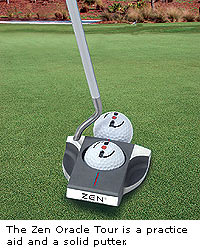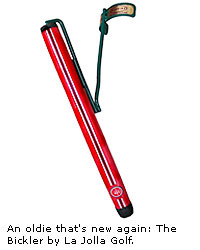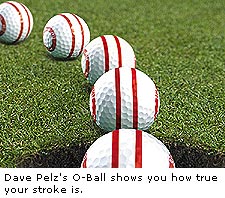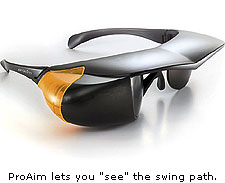|
STICKS & STONES
|
|
Same goes for training aids. I may be overly generous, but I believe that all but a tiny fraction of truly idiotic devices can be useful. Not useful to everyone, mind you. But useful to those golfers whose games suffer from the specific defects addressed by the given device. The job of each individual golfer is to figure out what his or her own flaws are (hopefully in consultation with an instructor). Only then should the money be spent on training aids.
With this in mind, I've sifted through the new training aids on the market this year, worked extensively with all of them, and sought advice and feedback from pros. Because more duffers piddle away strokes on the green than anywhere else, we'll focus on putting aids this month. Next month, we'll look at full-swing instructional aids.
 Zen Oracle Tour Putter
Zen Oracle Tour Putter
It's always a plus when a training aid can actually be used as a club (not an aid -- that would be illegal) on the course. The new Zen Oracle Tour Putter (zenoracle.com, MSRP $160) is just such a device. It is a mallet putter with a golf ball-sized hole behind the putter face. The hole serves as the putting aid. The rest of the putter is, well, a putter.
In practice, the idea is to take your normal putting stroke with the ball in the hole. Because its position is behind the putter face, the ball stays on the swingline longer than it does coming off an actual putt. Deviations from a straight line result in accentuated pushes or pulls.
A very nice feature is that one can use this to check the path of your backswing as well as the actual stroke. If you can hole "putts" behind and in front of you by releasing the ball from the Zen Oracle's middle, you will find it quite easy to do the same using the it as a regular putter, as long as your flaw is in swingpath, rather than pace. Peter Lonard actually won the 2003 Australian Open using one of these.
ProAim Virtual Alignment Trainer
In putting, there are basically three keys to alignment: Body alignment to the hole, body alignment to the ball, and the alignment of the clubface to the ball. Get all of these right, and the putt will go straight (never mind the break for now). ProAim (proaim.com, MSRP $130), which is pitched by Butch Harmon and plugged by touring pros Mark Calcavecchia and Natalie Gulbis, provides feedback on all three of these alignment points.
ProAim is a pair of goggles you wear on the practice green. By using a mirror to reflect natural light, a set of bright orange lines is projected onto one of the goggle lenses (though it looks like the lines are in both right and left fields of vision). These lines allow you to align your body and clubface with the ball. If your swing stays between the two horizontal lines, the swingpath is good. If the putter face stays parallel to the vertical line, it is square to the ball.
One excellent use of the ProAim is checking body alignment to the hole. First, you set up to the ball. Then, swivel your head (moving ONLY your head!) to look at the hole. If you're aligned correctly, the horizontal lines will track along the ground, ending up on either side of the hole.
The drawback to ProAim is its snug fit; some of the larger-headed folks we asked to test it were uncomfortable. A golfing ophthalmologist suggested that it would not be hard to incorporate a mechanism to adjust for pupilary distance, so that people with wide- or narrow-set eyes would be more comfortable using it. He also suggested making the fit roomier so that golfers with glasses could more easily fit it over their specs.
 The Bickler
The Bickler
A decade ago, a rather simple but effective putting aid was used by over 100 touring pros around the world. The Bickler (ljcgolf.com, MSRP $25) looked la bit like the arm-brace of one of those high-tech crutches. It strapped onto the grip of any putter, and by placing your right forearm (or left forearm for lefties) in the crutch, it maintained the crucial triangular relation between arms and grip. This took the wrists out of the stroke, and promoted the coveted pendulum swing.
La Jolla Golf has brought back The Bickler in conjunction with the introduction of the company's new Geometrical Alignment System (GA Series) putters (MSRP $109). The main feature of these putters is their unique alignment system: There is an arced line on the top of the putter that lines up with a circle on the base of the putter. As the golfer stands over the putter, he or she must connect the lines to create a perfect circle, which when lined up gives proper loft, lie, hand position and face angles. Each putter comes with a free Bickler. The two together promise to be a potent aid for those who struggle with handsy putting strokes.
 Pelz Golf O-Balls
Pelz Golf O-Balls
Last but not least, comes a simple but effective aid for making sure the clubface is square at impact, and the swingpath is straight. Short-game guru Dave Pelz's O-Balls (pelzgolf.com, MSRP $14.50/sleeve) have four red or black lines drawn on them, two in the middle and one at either end. If both swing and contact are pure, the lines will stay straight as the ball rolls. If not, they will wobble. With practice, you'll be able to associate various swing deficiencies with differing wobbles. If you've got a steady hand and a Sharpie, you can save the $15 and draw lines on your own balls.
Next Month: Full-swing aids.
Any opinions expressed above are those of the writer and do not necessarily represent the views of the management. The information in this story was accurate at the time of publication. All contact information, directions and prices should be confirmed directly with the golf course or resort before making reservations and/or travel plans.
